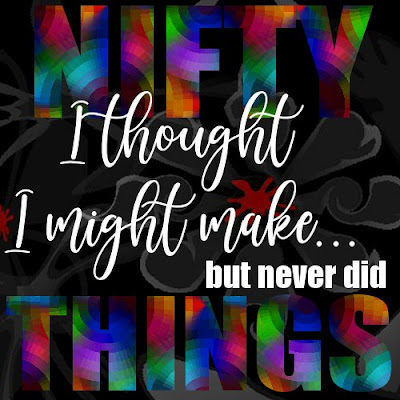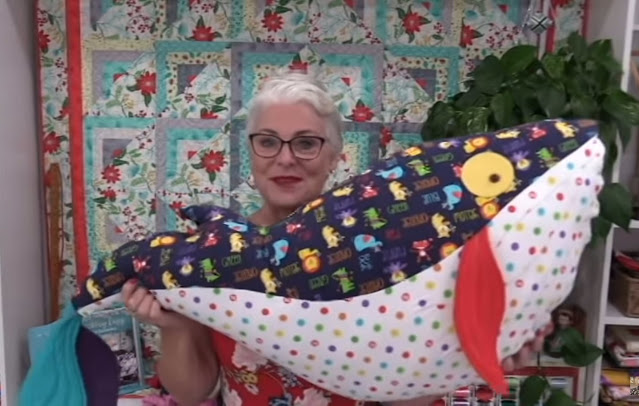
|
| Lost opportunities or "never meant to be"s? |
I've said here that before I got back into sewing in 2012, I hadn't realized
that people sewed things other than quilts and clothing.
As someone who loves to explore the back story on how things come to be, I'm
a little bummed that there is nothing to be found about this project's
origins.
Watch live classes for FREE at CreativeLive!

[affiliate link]
Check out crafty classes at Creativebug!

[affiliate link]
By the way, the trophy heads projects are one of the few things I've featured in this series of posts (most recent one here) that is actually from a paid pattern. If you'd like to try out the idea without committing actual dollars, you can find freebies online (do a search for free faux taxidermy sewing patterns). I didn't find many, but there are at least two deer head projects and a flamingo.
'Til next...
I then began my renewed sewing adventure by making bags and pouches, but
something else surprised me as I progressed on my journey: we can sew almost anything!
What I mean by that is, who would have thought that
chickens
would be such a popular thing to sew? (I certainly never could have
guessed how popular chickens might be among my handful of regular
readers.)
But how about a tea pot and tea cup set? I found one early on and thought
— what a unique sewing project!

The Mad Hatter Tea Set is a mostly hand sewn project, put out in 2013 by Kris DeGraeve. (She describes it as entirely hand sewn, but there are various places where it would be possible – and obviously faster – to use a sewing machine.)

The Mad Hatter Tea Set is a mostly hand sewn project, put out in 2013 by Kris DeGraeve. (She describes it as entirely hand sewn, but there are various places where it would be possible – and obviously faster – to use a sewing machine.)

|
| The famous Mad Hatter Tea Set by Kris DeGraeve... |
You can still find the original fourteen page PDF for this online (search
for
mad hatter tea set sewing pattern). It contains full templates,
photos, and instructions on how to recreate this utterly charming fabric
tea set.
It's undoubtedly as original as you're going to find when it comes to
sewing patterns, but I've always wondered what made the creator go to such
lengths to make a pattern for this and then not charge for it. (Not that I
would question true altruism.)
I've also said before that I would never make this – due to all the hand
sewing involved – but on occasion, I've considered the possibility of
making
one of the components, like maybe just the teapot. As you might
guess, there are many, many darts involved in making the teacups and
that gives me pause.
Who knows? Maybe in the coming years, the right inspiration will hit.
But for now, I don't see the complete set ever being on my "to do" list.
Despite not having any specific affinity to cats, this
Pointy Kitty stuffed cat caught my attention the very
first time that I saw it. It's a creation by Hillary Lang at
Wee Wonderfuls and first came out in 2005.

|
| Pointy Kitty by Hillary Lang... |
The instructions only take up one page of the PDF, but it was this
specific part of the instructions that stopped me from attempting this
when I first read it:
Turn pieces right side out. I’m not going to lie to you, Pointy
Kitty is a bear to turn out. Be careful not to split seams open
while turning out those narrow apendages. [sic]
When a designer offers up a truthful assessment of how difficult
something might be, I would say it's best to take it at her word.
I had the tea set, this cat and the
Purl Bee Penguin
in my sights at one point. Given that I eventually made a modified penguin with some success, I consider this "challenge of the
small stuffies" met and don't need to prove myself further. ʘ‿ʘ

What about large stuffies, then? And on that note, what's larger than a whale??
In 2014, someone named Marion at
Camelot Fabrics came up with a tutorial and PDF template
for making a whale... Wallace the Whale to be exact.

|
| Wallace the Whale (for size reference)... |
Even though this is a big project that I would normally shy away from
simply for the fabric requirements, I was drawn to it because it's
something that can easily be made out of old bedding (sheets,
pillowcases, old pillows). It's very much a recycling friendly project
if you look at it that way.
Oh, and I didn't come across this until a few years ago, but
Riley Blake created an even bigger whale named
Wesley.

|
| Wesley with Laura at SewVeryEasy (image courtesy of YouTube)... |
I suppose you can use old bedding to make this guy too, but you'll
need a lot of old pillows to stuff him!
Last – but certainly not least – how about some faux taxidermy?
Hanging stuffed heads of dead animals on a wall is not my kind of
thing, but when it's a sewing project, it's totally cool.
During my first ever visit to Makerist, I picked up this pattern for $2 from
B Trendy/Made by Oranges. (It's no longer for sale on Makerist,
but can still be found online.)

|
| "Wally" pattern from B Trendy... |
As you can see, it's a pattern that shows you how to make three
different "trophy" heads: an elephant, a lamb (sheep!) and a swan.
The appeal of the lamb is self-explanatory, but my cousin's son was into elephants, so I thought – at $2 – this wouldn't be a bad
pattern to have and hold.
But when I opened up the PDF and saw this pattern layout page
describing how to print and cut the pieces for each of the individual
projects, I got an instant headache.
It's one of those overlapping template layouts commonly found in
books. (I suppose it makes sense because B Trendy apparently has its
origins in the magazine world.)
There's no getting away from the fact that I haven't attempted to make
these trophy heads just because of these templates. (Cousin's son is
now twenty-three years old. He might still appreciate a faux taxidermy
elephant head, but I'm not likely to make one any time soon!)

By the way, the trophy heads projects are one of the few things I've featured in this series of posts (most recent one here) that is actually from a paid pattern. If you'd like to try out the idea without committing actual dollars, you can find freebies online (do a search for free faux taxidermy sewing patterns). I didn't find many, but there are at least two deer head projects and a flamingo.
'Til next...




I absolutely agree with you about those patterns all printed on the same page in different colours. You have to be really keen to want to trace them all. I suppose it could be worse if they weren't to scale
ReplyDeleteLOL — you're absolutely right! It would be worse if they weren't to scale. I didn't even check to see if this one was, but I know that some books are like that.
Delete